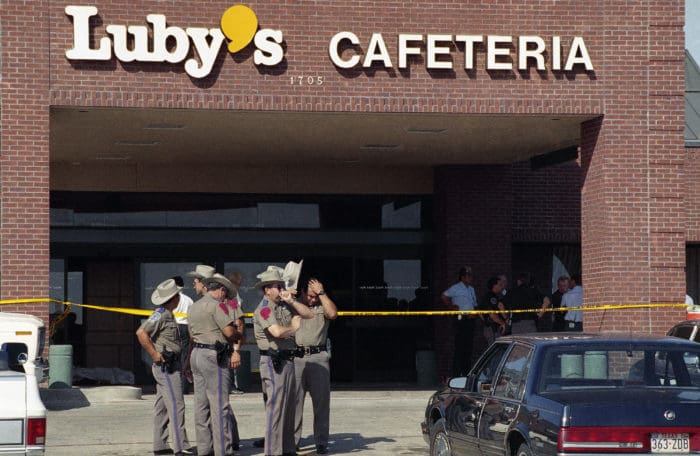I recently had a discussion with a well-educated friend. She’s articulate, opinionated and unafraid to share her perspectives. She believes the world would be better off without guns. She is also of the opinion that an individual should have to prove they have the right to carry a gun (“may issue”), rather than the putting the onus on the state to prove that an individual should not have that right (“shall issue”).
We agreed to disagree. But that got me to thinking, how did we get here?
When I was growing up in Louisiana, gun permits were a rare thing. To get a permit to carry a gun in his car, my dad had to go to the sheriff’s office and apply to become an auxiliary deputy sheriff. Otherwise, a citizen wishing to carry a handgun outside of his home was SOL. And back then, owning a handgun automatically placed you under suspicion. No doubt my African American friends had an even tougher time of it.
Fast-forward to today, and handgun laws have done a 180. In my adopted home state of Texas, the advent of new, more “lenient” conceal carry laws was met with fear and loathing by their opponents. They predicted a return to the Wild West, with armed citizens ready, willing and apt to go all John Wayne on anybody who crossed them.
Of course, that didn’t happen. In fact, statistical analysis of gun-related injuries and deaths in states that have conceal carry laws show that gun violence has decreased. Citizens that conceal carry are statistically unlikely to perpetrate gun crimes. As gun rights have expanded and hurdles to carry have been knocked down, the violent crime rate has fallen to new lows (until 2020’s civil unrest).
And yet antipathy remains. One of the many aspects of the Biden gun control agenda is to incent states to set up their hown gun licensing requirements (think Illinois), requiring government permission just to buy a firearm.
“You would want to carry your gun into this restaurant?” my anti-gun amiga demanded. “What if everybody in here had guns? Don’t you think there’d be trouble? Don’t you think that some of the people in here have no business having guns?”
Interesting questions all. And they share that Louisiana sheriff’s underlying supposition: if you’re carrying, you’re up to no good. They also assume that people are idiots (hard to argue that one sometimes, but still), and that any idiot can qualify for a concealed handgun license.
In point of fact, The Lone Star State performs background checks (extensive background checks, actually) on Concealed Handgun (CHL) applicants, as do most states that issue permits.
Anyway, to understand how and why things changed, at least here in Texas, we have to go back to a sleepy little town called Killeen, one October day in 1991.
It was lunchtime. The town’s cafeteria was a bustling place. In the twinkling of an eye, a pickup truck crashed through the plate glass windows and came to rest inside the restaurant. A local vet ran to the driver’s door, thinking that the driver must have passed out, had a heart attack, or was otherwise injured. No such luck. The vet was shot dead where he stood.
Exiting his Ford Ranger pickup, George Jo Hennard, Jr. exclaimed, “This is what Bell County did to me!” Walking calmly through the restaurant, Hennard put his guns (a GLOCK 17 and a Ruger P89) to the bodies or foreheads of the Luby’s patrons and pulled the trigger.
A loner who often told anyone who would listen, “One day they would all see what I’m was capable of,” Hennard reloaded several times. He targeted women over men (he’d earlier been accused of stalking a neighbor and her two daughters). The total carnage: 23 people murdered, 20 more wounded.
The police arrived, chasing Hennard into a bathroom where they wounded him. Hennard then put a gun to his head and pulled the trigger.
Why did he do it? Nobody knows. What we do know: a young woman, Suzanna Hupp, owned a handgun. But she’d left it just a couple of dozen feet away, in her car, as she dined with her parents.
Her father charged Hennard during the massacre…and died trying to stop him. Hupp’s mother was shot and killed. Hupp was unable to do anything to stop Hennard. She was obeying the gun laws in effect at the time and wasn’t carrying her gun.
Texas law then held that it was illegal to carry a concealed handgun unless you were a member of law enforcement. Hupp later stated that she regretted that she’d obeyed the law and left her gun in the car. If she’d had it in her purse, she might have been able to shoot Hennard before he murdered so many in cold blood.
As a result of that tragedy, the Texas Legislature passed a law known as “Shall Issue,” which puts the burden on law enforcement/government to prove why a person shouldn’t carry a gun, rather than on the individual to prove they deserve that right. Then-Texas Governor George W. Bush signed the bill into law. Suzanna Hupp was later elected to the state Legislature and served six terms.
So my friend’s question about carrying in a restaurant was more appropriate than she could have guessed.
Thankfully, I’ve never had an experience with gun violence as horrific as the patrons of Luby’s did that fateful day in October of 1991. But the spree killing — and Hupp’s advocacy — spurred the legislature to change the law to allow responsible citizens to carry concealed weapons.
Do I think it’s essential to carry concealed weapons while dining? Nope. But if someone came into the restaurant, guns a-blazing, aiming to kill strangers and make a name for themselves, I would hope that somebody in the joint had a permit, and the good sense to carry the day.
This article was originally published here in 2010.
